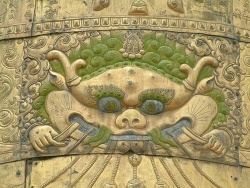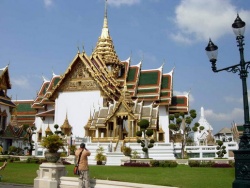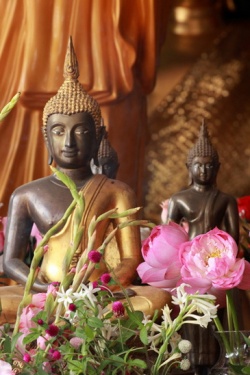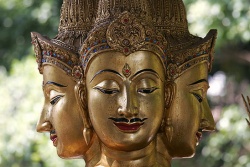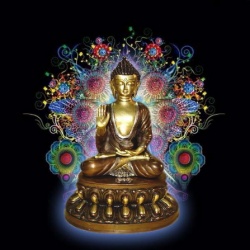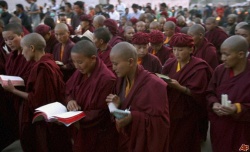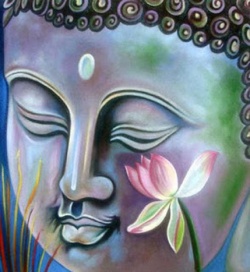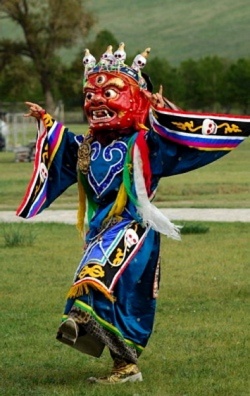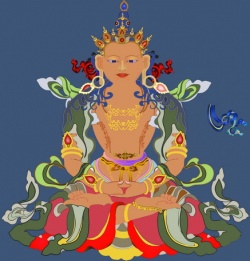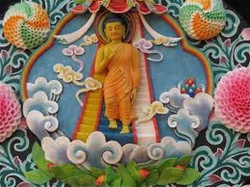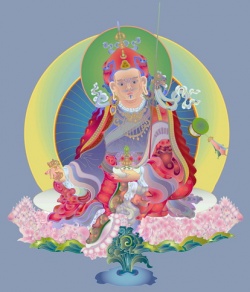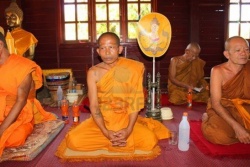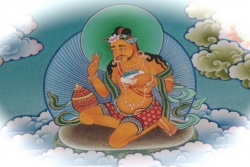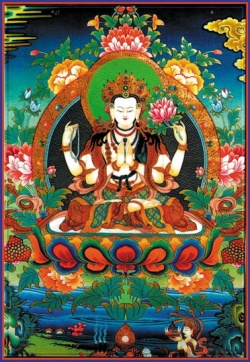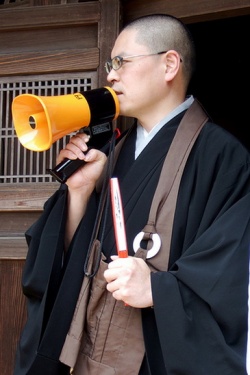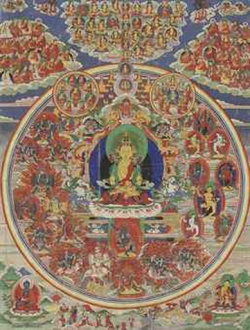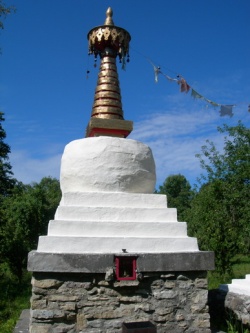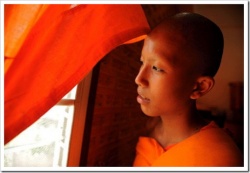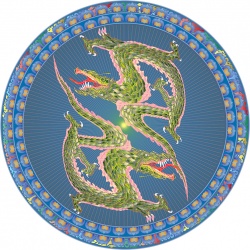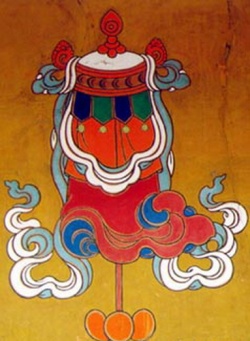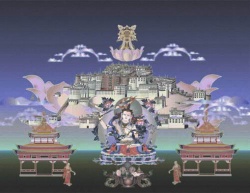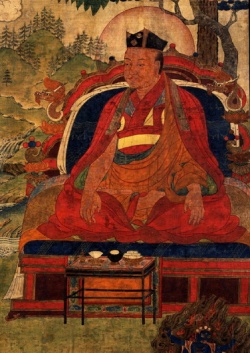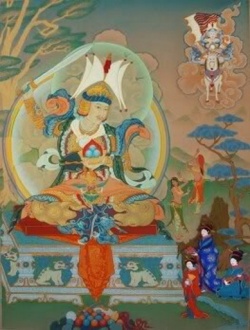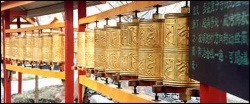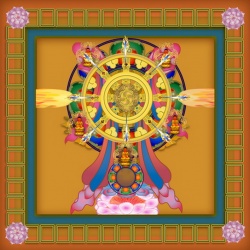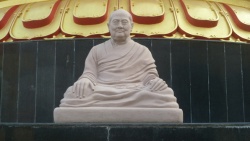Prostrations to the Thirty-five Buddhas – The Bodhisattva’s Confession of Ethical Downfalls
Prostrations to the Thirty-five Buddhas –
The Bodhisattva’s Confession of Ethical Downfalls
Transcribed and lightly edited teaching given by Ven. Thubten Chodron at Dharma Friendship
Foundation, Seattle, USA; January 2000.
The text that we will study now is the Sutra of the Three Heaps (Skt: Triskandhadharmasutra). The three heaps or collections of activities that we do in conjunction with it are confessing (revealing our unskillful actions), rejoicing, and dedicating. This sutra is found within a larger sutra, The Stack of Jewels Sutra (Skt: Ratnakutasutra) in the chapter called “The Definitive Vinaya.” Nagarjuna wrote a commentary to this sutra entitled The Bodhisattva’s Confession of Ethical Downfalls (Skt: Bodhipattidesanavrtti), which is the name we often use in English to refer to the practice.
Why do we need to purify? Because our mind is full of rubbish. Have you noticed that your mind is full of all sorts of illogical thoughts, disturbing emotions, and obsessions? These afflictions are not the nature of the mind. They are like clouds covering the clear sky. They are temporary and can be removed. It is to our advantage to remove them. Why? We want to be happy and peaceful and to be free from suffering, and we want others to be so as well. From our own experience, we know that under the influence of the afflictions – disturbing attitudes and negative emotions – we act in ways that harm ourselves and others. The results of these actions can go on a long time after the action itself has stopped. These two – afflictions and actions (karma) – are the true origins of our suffering, and we need to eliminate them. To do this, we must realize emptiness, the deeper mode of existence. To do this, we must develop concentration, and to do this, we first need to abandon destructive actions, engage in positive ones, and purify the destructive actions we have created in the past. The practice of prostrating to the thirty-five Buddhas and reciting and meditating on the meaning of “The Bodhisattva’s Confession of Ethical Downfalls” is a potent method to purify the karmic imprints that obscure our mind, prevent us from gaining Dharma realizations, and lead us to suffering.
Our mind is like a field. Before we can grow anything, such as realizations of the path, in it, we have to clean the field, fertilize it, and plant the seeds. Prior to planting the seeds of listening to Dharma teachings, we need to clear away the garbage in the field of the mind by doing purification practices. We fertilize our mind by doing practices which accumulate positive potential.
Purification practice is very helpful spiritually as well as psychologically. A lot of the psychological problems we have stem from negative actions we’ve done in this life and previous lives. So the more we do purification practice, the more we learn to be honest with ourselves. We stop denying our internal garbage, come to grips with what we’ve said and done, and make peace with our past. The more we’re able to do this, the happier and more psychologically well-balanced we’ll be. This is a benefit that purification brings this life. Purification is also helpful for us spiritually and benefits us in future lives. It’s going to take us many lifetimes to become a Buddha, so making sure we have good future lives in which we can continue to practice is essential. Purification eliminates negative karmic seeds that could throw us into an unfortunate rebirth in the future. In addition, by eliminating karmic seeds, purification also removes the obscuring effect they have on our mind. Thus we will be able to understand the teachings better when we study, reflect, and meditate on them. So to progress spiritually, we need to purify.
Despite all these benefits to be derived from revealing and purifying our mistakes, one part of our mind has some resistance to it. There’s the thought, “I’m ashamed of the things that I’ve done. I’m afraid that people will know what’s going on in my mind and then they won’t accept me.” With this in the back of our mind, we cover up what we’ve done and what we’ve thought to the point where we can’t even be honest with ourselves, let alone with the people we care about. This makes for a painful mind/heart.
The word “shak pa” in Tibetan is often translated as “confession,” but it actually means to reveal or to split open. It refers to splitting open and revealing the things we’re ashamed of and have hidden from ourselves and others. Instead of our garbage in a container festering under the ground, growing mold and gook, we break it open and clean it out. When we do, all the festering mess clears up because we stop justifying, rationalizing, suppressing, and repressing things. Instead, we just learn to be honest with ourselves and admit, “I made this mistake.” We are honest but we don’t exaggerate it either, saying, “Oh, I’m such an awful person. No wonder no one loves me.” We just acknowledge our mistake, repair it, and go on with our life.
The Four Opponent Powers
Power of Regret
Power of Reliance/Repairing the Relationship
Power of Determination not to Repeat the Action
Power of Remedial Action
Purification is done by means of the four opponent powers. The first one is the power of regret for having acted in a harmful way. Note: this is regret, not guilt. It’s important to differentiate these two. Regret has an element of wisdom; it notices our mistakes and regrets them. Guilt, on the other hand, makes a drama, “Oh, look what I’ve done! I’m so terrible. How could I have done this? I’m so awful.” Who is the star of the show when we feel guilty? Me! Guilt is rather self-centered, isn’t it? Regret, however, isn’t imbued with selfflagellation.
Deep regret is essential to purify our negativities. Without it, we have no motivation to purify. Thinking about the suffering effects our actions have on others and on ourselves stimulates regret. How do our destructive actions hurt us? They place negative karmic seeds on our own mindstream, and these will cause us to experience suffering in the future.
The second opponent power is the power of reliance or the power of repairing the relationship. When we act negatively, generally the object is either holy beings or ordinary beings. The way to repair the relationship with holy beings is by taking refuge in the Three Jewels. The relationship with the holy beings was damaged by our negative action and the thought behind it. Now we repair that by generating faith and confidence in our spiritual mentors and the Three Jewels and taking refuge in them. The way to repair the relationships we’ve damaged with ordinary beings is by generating bodhicitta and having the wish to become a fully enlightened Buddha in order to benefit them in the most far-reaching way.
If it is possible to go to the people we have harmed and apologize to them, that’s good to do. But most important is to reconcile and repair the broken relationship in our own mind. Sometimes the other person may be dead, or we have lost touch with them, or they may not be ready to talk with us. In addition, we want to purify negative actions created in previous lifetimes and we have no idea where or who the other people are now. In other words, we can’t always go to them and apologize directly.
Therefore, what’s most important is to restore the relationship in our own mind. Here, we generate love, compassion, and the altruistic intention for those whom previously we held bad feelings about. It was those negative emotions that motivated our harmful actions, so by transforming the emotions that motivate us, our future actions will also be transformed. The third of the four opponent powers is the force of determining not to do it again. This is making a clear determination how we want to act in the future. It’s good to pick a specific and realistic length of time for making a strong determination not to repeat the action. Then we must be careful during that time not to do the same action. Through making such determinations, we begin to change in evident ways. We also gain confidence that we can, in fact, break old bad habits and act with more kindness towards others.
With regard to some negative actions, we can feel confident that we’ll never do them again because we’ve looked inside and said, “That’s too disgusting. Never again am I going to do that!” We can say that with confidence. With other things, like talking behind other people’s back or losing our temper and making hurtful comments, it may be more difficult for us to say confidently that we’ll never do again. We might make the promise and then five minutes later find ourselves doing it again simply because of habit or lack of awareness. In such a situation, it’s better to say, “For the next two days I won’t repeat that action.” Alternatively, we could say, “I will try very hard not to do that again,” or “I will be very attentive regarding my behavior in that area.”
The fourth opponent power is the power of remedial action. Here we actively do something. In the context of this practice, we recite the names of the 35 Buddhas and prostrate to them. Other purification practices include such activities as reciting the Vajrasattva mantra, making tsa-tsas (little Buddha figures), reciting sutras, meditating on emptiness, helping to publish Dharma books, making offerings to our teacher, a monastery, Dharma center, or temple, or the Three Jewels. Remedial actions also include doing community service work such as offering service in hospice, prison, volunteer programs that help children learn to read, food banks, homeless shelters, old-age facilities – any action that benefits others. There are many types of remedial actions that we can do.
Initial Visualization
There are several different ways to visualize the 35 Buddhas. Je Rinpoche visualized all the Buddhas in a circular pattern around Shakyamuni Buddha. They were different colors with different hand gestures and hold different hand implements. There are some photographs and thangkas showing this way of visualization.
The visualization that I’m going to describe here is easier. Here, there are five rows of Buddhas, corresponding to the five Dhyani Buddhas. In general, all the Buddhas in one row have the same hand gestures and the color of a particular Dhyani Buddha.
Shakyamuni Buddha is above and in the center. From his heart, 34 light beams come out forming five rows. The top row has six light beams with six thrones, one at the end of each beam. Then, the second through the fifth rows all have seven light beams with seven thrones, one at the end of each light beam. Each throne is supported by elephants, indicating very strong purification because elephants are mighty. All the Buddhas sit on a seat of lotus, moon, and sun, symbolizing the three principal aspects of the path.
Shakyamuni Buddha in the center is golden in color and his hands are in the gestures generally depicted in paintings. His left palm is in his lap holding an alms bowl, and his right palm on his right knee with the palm down in the earth touching gesture. The text begins with, “To the Founder, the Transcendent Destroyer, the One Thus Gone, the Foe Destroyer, the Fully Enlightened One, the Glorious Conqueror from the Shakyas, I bow down.” That is prostration to Shakyamuni Buddha.
In the first row with the six light beams are the next six Buddhas mentioned in the text. They resemble Akshobya Buddha and are blue in color. The left hand is in the lap in meditative equipoise, and the right hand is in the earth touching position with the right palm facing down on the knee. The fourth one, the One Thus Gone, the King with Power over the Nagas, is an exception. He has a blue body and a white face and his hands are together at his heart.
In the second row, the next seven Buddhas also sit on light beams and thrones. Prostrations to these Buddhas begin with “To the One Thus Gone, the Jewel Moonlight, I bow down.” These seven Buddhas resemble Vairocana. They’re white in color with both hands at the heart, the index fingers extended.
In the third row, prostrations to the next seven Buddhas start with “To the One Thus Gone, the Celestial Waters, I bow down.” These Buddhas resemble Ratnasambhava, who is yellow in color. His left hand is in meditative equipoise and his right hand rests on the right knee, palm facing outwards in the gesture of giving.
In the fourth row, starting with “The One Thus Gone, the Son of the Desireless One,” those seven Buddhas resemble Amitabha. They’re red and both hands are in their laps in meditative equipoise.
In the fifth row are seven green Buddhas starting with “The One Thus Gone, The King Holding the Banner of Victory Over the Senses.” They resemble Amoghasiddhi and are green. The left hand is in meditative equipoise and the right hand is bent at the elbow with the palm facing outward. This mudra is called the gesture of giving protection; sometimes it is also called the gesture of giving refuge.
Do the visualization as best as you can. Don’t expect to have it all perfect. The most important thing is to feel like you’re in the presence of these holy beings. As you say each name, concentrate on that particular Buddha.
Prostrating
Prostrations may be physical, verbal, and mental. We have to do all of them. Physically, we do short or long prostrations. When we do the purification practice with the 35 Buddhas, it’s nice to do the long ones. If you have physical limitation and can’t bow down, just putting your palms together in front of your heart is considered physical prostration.
Physical prostrations include the long and the short versions. Both begin with putting our hands together. The right hand represents method or the compassion aspect of the path, and the left hand represents the wisdom aspect of the path. By putting our two hands together, we show that we’re trying to accumulate and then unify method and wisdom to attain the form body and the truth body – the rupakaya and dharmakaya of a Buddha. Tucking our thumbs inside the palms is like coming to the Buddha holding a jewel – the jewel of our Buddha nature. The space in between our palms is empty, representing the emptiness of inherent existence.
Prostrations begin with touching our hands to our crown, forehead, throat and heart. First touch the crown of your head. On Buddha statues, the Buddha has a small protuberance on his crown. It’s one of the 32 major marks of an enlightened being. He received this due to his great accumulation of positive potential while he was on the bodhisattva path. The reason that we touch our crown is so that we, too, may accumulate that much positive potential and become a Buddha.
Touching our forehead with our palms represents purifying physical negativities such as killing, stealing, and unwise sexual behavior. It also represents receiving the inspiration of the Buddha’s physical faculties. Here, we especially think of the physical qualities of a Buddha. We imagine white light coming from the Buddha’s forehead into ours and think that the light performs those two functions: purifying the negativities we created with our body and inspiring us with the Buddha’s physical capabilities. We can also feel inspired by the nirmanakaya, the emanation body of a Buddha.
Next, we touch our throat and imagine red light coming from the Buddha’s throat into ours. This purifies verbal negativities such as lying, divisive speech, harsh words, and idle talk or gossip. It also inspires us so that we can gain the Buddha’s verbal capacities. These include the 60 qualities of an enlightened being’s speech. We can also think of the qualities of the sambhogakaya, the enjoyment body of a Buddha.
Then, we imagine deep blue light coming from the Buddha’s heart into ours. This purifies all mental negativities such as covetousness, maliciousness, and wrong views. It also inspires us with the qualities of the Buddha’s mind, such as the eighteen unique qualities of an enlightened being, the 10 powers, the 4 fearlessnesses, and so on.
To do a short prostration, now put your hands on the floor with your palms flat and fingers together. Then put your knees down. Touch your forehead to the floor and push yourself up. This is also called the five-point prostration because we touch five points of the body to the floor: two knees, two hands, and the forehead. That’s how to do the short prostration.
If you’re doing long prostrations, after touching your crown, forehead, throat, and heart with your hands, put your hands down on the floor, then your knees. Then put your hands some distance in front of you, lie down flat, and stretch your hands out in front of you. Next, put your palms together and lift your hands at the elbow as a gesture of respect. Some people lift their hands at the wrist. Put your hands back down, and then move them so that they’re about even with the shoulders, and push yourself back up to a kneeling position. Then, move your hands back again next to the knees, and at that point, push yourself back up to a standing position.
When doing long prostrations, some people slide the rest of the way down after putting their hands on the floor. That’s also ok. Just be sure to have some kind of pads under your hands, otherwise they get scratched up. When you move your hands on the way up, move both of your hands in sync, not one by one as if crawling.
Don’t stay on the ground long. In the Tibetan style of prostrations, we come up quickly symbolizing that we want to come out of cyclic existence quickly. In other traditions, such as the Chinese Buddhist tradition, they stay down for a long time to give more time to visualize. In this case, there’s a different symbolic significance in the prostrations, which has its own beauty.
Verbal prostration is saying the names of the Buddhas with respect.
Mental prostration is having deep respect, faith, and confidence in the Three Jewels and their ability to guide us. Mental prostration also includes doing the visualization with the lights coming to purify and inspire us.
Doing the Practice
It’s good to do this practice at the end of each day. Start by reflecting on the things in your day that you want to purify. Or, think of everything you’ve done since beginningless time and purify the whole batch. What’s best is to do the four opponent powers with respect to all negative actions done in this and previous lives, even if we can’t specifically remember them. We think of the ten destructive actions in general, but also pay particular attention to purifying the ones we do remember, whether we created them that day or earlier in our life. Then, do three prostrations saying, “Om namo manjushriye namo sushriye namo uttama shriye soha.” Saying this mantra increases the power of each prostration so that it increases the purification and the creation of positive potential. Then say, “I, (say your name), throughout all times, take refuge in the Gurus; take refuge in the Buddhas; take refuge in the Dharma; take refuge in the Sangha.” Of the four opponent powers, that is the branch of taking refuge.
This is a good practice to do daily, in the morning – to wake you up (among other benefits) – and in the evening to purify any destructive actions you may have done during the day. Making prostration is also one of the ngondro or preliminary practices. “Preliminary” doesn’t mean they are simple! It means we do them as preparation to Vajrayana practice, especially to purify and eliminate obstacles prior to doing a long retreat on a deity. Other preliminaries are taking refuge, offering the mandala, reciting Vajrasattva mantra, and guru yoga. In addition, more preliminaries are the Dorje Khadro (Vajra Daka) practice, the Damtsig Dorje (Samaya Vajra) practice, offering water bowls, making tsa-tsas. As a preliminary practice, you do 100,000 of each of these, plus 10% to make up for any errors, for a total of 111,111.
If you do prostrations every day and are not counting them as part of your ngondro, you can repeat one name of a Buddha after the other while prostrating. Then continue to prostrate while saying the prayer of the three heaps – confession, rejoicing, and dedication. If you’re counting the prostrations, an easy way to count it is to do one prostration to each Buddha while reciting that Buddha’s name repeatedly. Some names are shorter so you can say more of them during one prostration; others are longer and you can’t say as many. It doesn’t matter. By bowing one time to each Buddha, you know that you’ve done 35 prostrations right there so you don’t need to be distracted by trying to count them. Count the number of prostrations you do while reciting the prayer of the three heaps. If you do this a few times, you will know approximately how many you do during each recitation. Thereafter, instead of counting each time you do the prayer, just add in that approximate number. In that way counting doesn’t become a distraction. This is important, for you should focus on having regret, doing the visualization, and feeling purified, not on counting numbers.
To memorize the Buddhas’ names, make a tape and say the name over and over again as many times as it takes to do one prostration. The more times you say the Buddha’s name, the more positive potential you create. Another way is to keep the book next to you, read one name and then say it over and over as you do one prostration. Then, when you’ve done that one, read the next Buddha’s name and say it over and over as you do the second prostration. As you say each name, think that you are calling out to that Buddha with the intention, “I want to purify all this rubbish so I can benefit sentient beings in the best way.” Memorizing the names is very helpful because then you can concentrate on the visualization and on feeling regret, admiration and respect for the Buddhas’ qualities, trust and confidence in the Three Jewels. The sooner you can memorize the prayer, the better the practice will be for you because you won’t be distracted by, “Which Buddha? What’s his name? I can’t remember.”
Another way to do the practice in which counting is easy is to recite the names all the way through one time, while prostrating to each one, and do that several more times and say the prayer of the three heaps once at the end. That is, you can do several sets of names and then the prayer. It depends how you like to do it. It’s up to you.
While you’re prostrating, think about specific things you want to purify. That will help you be more aware and conscious in your life and to reflect upon what you’ve done. It’s also good to think you’re purifying all the actions in a broad, general category, because who knows what we’ve done in our previous lives? So don’t just dwell on the fact that you criticized your sister today and forget to regret and purify all the other millions of times we’ve criticized others throughout infinite beginningless lives. We want to purify the whole lot of negative karma, although we might focus on certain actions that are really weighing heavy on us and think of them specifically when we do it.
The Prayer of the Three Heaps
The prayer that follows the Buddhas’ names is called the Prayer of the Three Heaps because it has three parts. The first part is confession, the second is rejoicing, and the third is dedication. It’s also good to memorize this prayer because then you can prostrate while reciting it.
Psychologically, I’ve found it very effective to say all these things that I’ve done wrong while I’m bowing and my nose is on the ground. Somehow, it really hits home that way, whereas when we stop and read the prayer because we haven’t memorized it, the ego isn’t hit quite as hard. So, I would really encourage you to memorize the names and the prayer so that when you do it in a group, you don’t have to stop and read it. Nor do you have to depend on another person or the tape recorder to read it for you. After all, it’s us that acted destructively, not the tape recorder, so we should own up to it by saying it ourselves.
When we do this practice in a group and somebody else is reading, we shouldn’t think that we don’t need to recite the names and the prayer. That’s like thinking the person reading the prayer will purify for us. Or, the tape will purify our negativities for us. But then, does the tape get the good karma? Of course the tape can’t get the good karma because the tape isn’t a sentient being! In the meantime, we miss out on acting constructively if we let the tape say the names and the prayer.
For that reason, the masters recommend that with any of these practices, such as making offerings, bowing, meditating, or reciting, we should do it ourselves. If we do prostrations, we should do it ourselves. If the names of the Buddhas are being said, we should say them ourselves. If we don’t, it’s like someone saying, “Julie, will you eat for me?” and then expecting to be full after she eats. It doesn’t work that way. We have to eat ourselves. It’s the same way with purification. We’ve got to do it ourselves. We can’t hire somebody else to do it for us.
1. Confession
Each of the Buddha’s names starts out with “To the One Thus Gone.” That’s “de zhin sheg pa” in Tibetan or “tathagata” in Sanskrit. “The One Thus Gone” means the one who has crossed over from samsara to enlightenment. It can also mean “The One Gone to Thusness,” “thusness” meaning emptiness. Here we bow to one who has realized emptiness. In the original sutra, the Buddhas’ names didn’t have the preface “The One Thus Gone.” When Lama Tsongkhapa did the practice, he initially had a vision of all the Buddhas but he couldn’t see their faces clearly. As he continued to do the practice, he added “The One Thus Gone” before each Buddha’s name as a way of showing his respect to them, and after that he had a very clear and vivid vision of all thirty-five Buddhas with their faces. That’s why that phrase is added, though it wasn’t in front of the names initially.
When I was in Tibet in 1987, I was able to visit Okka, the place where Lama Tsongkhapa did his prostrations. Although it was virtually destroyed by the Communist Chinese, you can still see the imprint of his body on the stone where he did prostrations. He did 100,000 prostrations to each of the 35 Buddhas – that’s three and a half million prostrations! It’s high altitude there, with cold weather and only tsampa (ground barley flour) to eat. If Je Rinpoche could do so many prostrations under those conditions, then we can easily do it here with our thick carpeting, a mat under our body, a pad under our knees, and a towel under our head. We can adjust the room temperature to make it warmer or cooler. There is water and even hot chocolate nearby! We can manage it!
This practice of bowing to the 35 Buddhas is from a Mahayana sutra and is also found in the Chinese Buddhist tradition. The Chinese tradition speaks of 88 Buddhas, of which 35 are the ones mentioned here. The prayer of the three heaps is the same too. One time when I was staying at City of 10,000 Buddhas in California, some of the chanting we were doing sounded so familiar. Then I realized that it was this practice. They followed it by reciting “The King of Prayers,” which is from the Mahayana sutra, the Avatamsaka Sutra, which both of our traditions share.
The prayer of the three heaps starts with “All you thirty-five Buddhas, and all the others.” When reciting the prayer, imagine the 35 Buddhas in front of you. Around you imagine all of your previous lives in human form. They are all bowing with you. In addition, remember that you’re surrounded by all sentient beings, who are also bowing to the 35 Buddhas with you.
To make it more elaborate, imagine this whole scene upon every single atom, throughout space. So there are infinite numbers of thirty-five Buddhas, and our infinite beginningless lives and infinite sentient beings prostrate to the Buddhas. Thinking like this has a powerful effect on the mind. We create much more powerful positive potential and the purification is stronger as well. It really stretches the mind and completely gets us out of our narrow way of thinking and opens us up so we remember all sentient beings.
To all you thirty-five Buddhas and all the others, those thus gone. The tathagatas are those who have realized emptiness. Foe destroyers, or arhats, are those who have destroyed the foe of the afflictions and are liberated from cyclic existence. Fully Enlightened Ones and Transcendent Destroyers are other epithets for the Buddha. Who are existing, sustaining, and living throughout the ten directions of sentient beings’ worlds. “Existing” refers to them having attained the dharmakaya, the mind of the Buddha, and “sustaining” and “living” refers to having attained the rupakaya, the form body of the Buddha. The rupakaya includes the sambhogakaya, the enjoyment body, as well as the nirmanakaya, the emanation body. The ten directions include the four cardinal directions, the four intermediate directions, and up and down. It means everywhere.
All you Buddhas, please give me your attention. We start out by asking the Buddhas to give us their attention, but what we’re really doing is saying to ourselves, “May I pay attention to you.” The Buddhas are always paying attention to us. We’re just not usually tuned into them. Asking them to pay attention to us is really a psychological tool to remind us to pay attention to them. When we tune into the fact that they’re paying attention to us, that they’re doing their best, day and night, to guide us to enlightenment, that they care about us, then we will automatically pay attention to them.
In this life and throughout beginningless lives. Think about that for a while.
Beginningless lives! That’s a long time. In all the realms of samsara. That means that we’ve been born everywhere in cyclic existence, and we’ve done everything in samsara. So there’s never any reason to feel that we’re special or better than anyone because every single action that sentient beings do, we’ve done before in our multiple, beginningless lives. When we seek to purify our negativities, there’s no reason to feel that we’re morally superior to others because we haven’t done all the awful things they have. When we consider infinite beginningless lives, it’s easy to imagine that we have been born in every sort of existence and done every type of action, positive and negative. The only thing we haven’t done in our previous lives is complete the path to liberation or to enlightenment. That means that sometime during our beginningless lifetimes, we’ve all acted like Hitler, Stalin, Mao Tse Tung, and Osama bin Laden. We’ve done everything, so there’s nothing for us to be arrogant about.
Remembering this is helpful because arrogance is a huge obstacle on the path. Thinking that we’re special or better than others creates a big block and impedes our spiritual growth, because if we think we’re already so great, we won’t think to improve ourselves. Then we remain smug and complacent while our precious human life slips by. However, having a spacious mind and being aware of our shortcomings automatically deflates that arrogance. It makes us humble. Then we are receptive to learning. Willing to listen to the advice of the wise, we’ll put it into practice and will reap the benefits.
In all the realms of samsara. We’ve been born in the hell realms, as hungry ghosts, and as animals. We have been born as desire realm gods with sense pleasure deluxe. We’ve been born in the realms of the form and formless gods, with great single-pointed concentration. In fact, we’ve been form and formless realm gods, abiding in samadhi for eons, so don’t think you have no ability to concentrate! You’ve been born there with all those abilities before. The point is that we never realized emptiness directly, so when we fell from that state, we kept revolving in samsara.
Now we start confessing, revealing our mistaken actions. I have created. I’ve done it myself. I’ve caused others to create. We have asked other people to do negative actions for us; we’ve encouraged their harmful actions. How often do we ask our friends or family to lie on our behalf? How often do we involve others in gossip about people behind their backs or criticizing them? How often have we encouraged others to cheat on this or that? We must reflect on not only the negativities that we have done but those we’ve asked, encouraged, or influenced other people to do.
Sometimes we don’t want to do a certain action because we are concerned that we might get caught, get hurt, or suffer ill effects. So we ask somebody else to do it for us, thinking that then it’ll be their problem to deal with. But, karmically, that doesn’t work. If we ask somebody else to commit a negative action, we get the same karma as if we did it ourselves because the motivation came from us. So here, we’re confessing all the negative influence we’ve had on others.
Sometimes the people we have a harmful influence on are the people we love the most. The people we’re closest to are the people that get involved in our gossip and divisive speech, in our schemes and shady business deals. They’re the ones that we ask to steal for us, to lie and cover up for us when we’ve done something wrong. It’s the people we love that we incite to speak harshly in order to stick up for us when we’re in a quarrel. It’s the people we love that we provoke to anger and harsh words by our obnoxious actions.
We need to think about this seriously. From a karmic viewpoint, are we helping or harming our dear ones? If we care about them and think about their future lives and enlightenment, would we still act towards them the way we do?
I have created, caused others to create, and rejoiced in the creation of negative karmas. Not only have we done or asked other people to do destructive actions, but when we’ve seen other people do them, we’ve said, “Great!” “The U.S. forces bombed Baghdad? Fantastic!” “They killed some suicide bombers? Super!” “My colleague lied to the boss and we all got more time off? Wonderful!” “This murderer was just sentenced to death. Great!” It’s very easy for us to think like that, isn’t it?
In other cases, we rejoice at others’ misfortune. “They caught that dishonest person and threw him in the can. I’m glad. I hope he gets beaten up in prison.” “The reputation of a person I’m competing with just got trashed. Hooray!” “This politician whom I don’t like is getting indicted? Finally!”
It’s extremely easy to rejoice at harmful actions others do or rejoice at others’ misfortune. Especially when we watch movies or the news or when we read the newspaper, if a part of our mind thinks, “Oh, Good,” about the effect of another’s harmful action, we create negative karma. So we have to be very careful and watch our mind when we’re in contact with the media because it’s easy to be judgmental and rejoice in others’ negative karmas, especially if we get some worldly benefit from it. Here, we confess all of this.
Next, some of the heavy negative karmas we’ve created are delineated. These include misusing offerings to holy objects. For example, we take things offered on an altar for our own personal use. It just happens to be lunchtime and we’re hungry and there is food on the altar so we’ll eat it. A friend stops over unexpectedly and we don’t have any cookies or fruit, so we take some from our altar to give him. Or if we go to a holy place and take things on that altar because we want a souvenir. People do this, let me tell you. When I first heard teachings on this, I wondered, "Who in the world would do these things?" Well, since then, I’ve seen and heard of people doing these actions. People go to Bodh Gaya and want a souvenir from the altar in the main shrine to put on their altar. They take it without asking anyone. It happens.
This also includes the case of someone giving us something to offer to the Three Jewels and we don’t offer it. For example, somebody gives us some money to offer at the temple at Bodh Gaya, and we spend it on ourselves. Or someone gives us a gift to give to her teacher, and we forget. Later when we remember, we think, “It was so long ago. I’ll just keep it for myself.” Or, someone gives us some cookies to offer to the sangha at a monastery, and we get hungry, eat them, and think that we’ll buy some other ones. No! When somebody has given something specific to offer, we have to offer exactly that thing and not think that we’ll use this one and replace it with something else. Once something has been mentally offered, it belongs to the Three Jewels; it doesn’t belong to us. All these actions and others are included in misusing offerings to holy objects.
Misusing offerings to the Sangha is misusing things that have been offered to the Sangha as a community or to arya Sangha as individuals. If we’re managing the Sangha’s money or an individual Sangha member’s money and misuse it, the karma is very heavy. Borrowing the possessions of a sangha community and not returning them, taking their things without asking permission, misusing Sangha property are included in misusing offerings to the Sangha.
Stealing the possessions of the Sangha of the ten directions. The Sangha of the ten directions refers to the entire Sangha community. The negativity created with the Sangha community is much heavier than other negativities because the object is a community. For example, if someone takes something from a monastery without asking, they have stolen from however many people there are in the community. If he wants to go to the Sangha and confess, he has to confess in front of the entire community. However, it’s not always the case that the same people who were in the community when he stole are still there when he returns the item and confesses. That makes it difficult to purify the transgression.
We have to be very careful around the Sangha community and its property. Those who are monastics can’t offer things belonging to the Sangha community to their relatives. They can’t give away the Sangha’s property without checking either with the manager of the community or with each member. Monastics can’t take Sangha property for themselves, especially money offered to the Sangha community. We have to be extremely careful with that.
It specifically mentions the Sangha here instead of just sentient beings of the ten directions because the negative karma is especially heavy stealing from those who have dedicated their lives to attaining liberation or enlightenment. The power of the object is greater. Sangha are people who have dedicated their lives to practicing the path. Having taken precepts, they are fully intent on gaining liberation and enlightenment. Therefore, depriving them of the means of their livelihood is much more serious than stealing from someone who is not intent on liberation, or someone who works for a living or has an income.
Actions, either positive or negative, done in relation to our spiritual mentors, the Buddha, Dharma or Sangha become very powerful. Why? As the object in relation to whom we act, they are very virtuous. Our mind has become very cloudy if we think virtuous beings are just like everyone else and treat them inappropriately. That doesn’t mean we idolize them. Rather, we respect their virtue because we want to be like them.
We create a lot of good karma or a lot of negative karma in relation to virtuous objects. One of the reasons why it’s possible in Tantra to attain enlightenment in one lifetime is because when we see our guru as an emanation of the Buddha and make offerings, we create incredible amounts of good karma. It’s very, very powerful good karma. On the other hand, if we get angry, we create very, very negative karma because it’s like getting angry with all the Buddhas. So we have to be very careful around the beings who are virtuous objects.
The prayer speaks about misusing offerings to the Sangha community. To broaden that a little, we have to be careful about the actions we do in relationship to a Dharma center. Although it is not as strong an object for the creation of karma, it is stronger than many other things in our life. For example, we may borrow books or tapes from the center’s library and not return them. This is stealing from the Dharma center. Someone managing the center’s finances may be careless, or worse yet, deliberately take money from the center. The person in charge of doing a certain job may keep extra supplies for themselves. We must be attentive and conscientious here. Conversely, offering service to a Dharma center or monastery, making offerings to them – as our monthly supporters do – assisting in organizing activities are actions that create a lot of positive potential. Why? Because the object is virtuous and because we’re helping sentient beings to meet the Dharma, which is the true source of benefit and aid that will cure their suffering.
I’ve caused others to create these negative actions and rejoiced in their creation. We admit that we have engaged in, encouraged others to do, or rejoiced in many negative actions, specifically those in relation to holy objects. Instead of pretending we haven’t done these in this or previous lives, we release the immense energy involved in denial and acknowledge our mistaken deeds. Honesty brings a tremendous sense of relief.
I’ve created the five heinous actions, caused others to create them, and rejoiced at their creation. These five are killing our father, killing our mother, killing an arhat, causing a schism in the Sangha community, and causing blood to flow from the body of a Buddha. Actually, some of these can only be done at the time of the nirmanakaya Buddha, but still we can do things that resemble such actions. We have to be especially mindful of not causing schism and disharmony in the Sangha community. This refers to dividing people into different groups through political means, gossip, or any other way. Why is this harmful? Because the Sangha members don’t function harmoniously together as ones intent on virtue but instead quarrel with each other, fighting over this and that. They waste their time, and people in society then lose faith in the Sangha. So, it’s extremely important not to cause schisms in the Sangha. We can extrapolate that to people in a Dharma center; we should not provoke them to engage in gossip, rivalry, or politics. Who can practice Dharma in a center where everyone is busy creating negative karma in a big power struggle?
There are various controversies in the Tibetan community nowadays. I recommend that we don’t get involved in any of them. Just be aware controversies exist and keep a distance. We come to the Dharma center for the Dharma, not for politics, and so we listen to the Dharma and practice it. If other people want to get involved in controversies, so be it, but we stay away and avoid creating a lot of negative karma.
We might think, “I would never do any of the five heinous actions.” Well, check up.
What if one of our parents says, “I don’t want to live any longer. Please help me kill myself. I’m in too much pain.” Of course, that’s not the same as killing a parent out of anger, but still if we assist them it’s contributing to our parent’s death. In our monastic vows, even encouraging death is a root downfall. We have to think carefully about that. We may think, “Who in the world would kill their mother?” I went to high school with a guy who went home one day and shot his mother and himself. I grew up in a “nice middle-class community,” where things like that aren’t supposed to happen. In addition, since we’ve been under the influence of ignorance, anger, and attachment since beginningless time, there’s the possibility that in a previous life we did these five heinous actions.
I have committed the ten non-virtuous actions, involved others in them, and rejoiced in their involvement. We might think that we don’t do the ten destructive actions very much. But we have to check up! Really check up, and check up closely. Are we really free from killing even little tiny beings like mosquitoes? We might think, “Oh, I didn’t actually see it!” when actually, we did. We need to see the ways we justify or rationalize our harmful actions.
We may think, “I don’t steal.” Check up to see if we repay and return exactly what we borrowed. Do you pay all your taxes and fees that you’re required to pay? Do you use office supplies for your own personal use? Do you make personal long distance calls that are charged to your workplace? All those things fall under stealing.
What about unwise sexual behavior? Look to see if you use your sexuality wisely and kindly, or if you’ve used it to manipulate others. Has anyone been hurt physically or emotionally because of the way you’ve used your sexuality? Many people nowadays easily get involved in unwise sexual behavior but don’t realize it until afterwards. This is something to be attentive about so that we don’t create problems for ourselves or suffering for others. Check up to see if you lie. It’s incredible. We might think that our speech is exact, but when we look closely, we find that we exaggerate. We emphasize one part of our story and not the other part so that the listener gets a skewed view. That’s deception, isn’t it? How about divisive speech? We’re upset with somebody and talk with our friend about it. And of course, my friend sides with me and gets mad at that same person.
It’s easy to talk behind someone’s back, use harsh words, or say very rude and insulting things to other people. We do it often. Sometimes we accuse others of doing, saying, or thinking things that they haven’t. We don’t bother to check with them what their actual intention was, but instead jump to conclusions and accuse them of doing this, that and the other thing. Or, we tease them or make fun of them, especially little children, in a way that hurts their feelings. Or sometimes we’re rude, judgmental, and unappreciative of other people. How much are we aware of what we do, say, and think? How honest are we with ourselves? We should avoid being smug, thinking, “Oh, ten negative actions. No problem,” or “These are small things. They’re not so bad.” These ten cover all aspects of our life. If we truly want to attain enlightenment, we must begin by abandoning gross harmful actions. We can’t do high practices when our daily life behavior is a mess!
Let’s examine if we engage in idle talk. How much time do we spend over things that aren’t really important? Do we waste a lot of time hanging out, talking about frivolous things just to be amused or to pass time?
Then there’s coveting. How much time do we spend planning how to get the things we want? “Oh, this is on sale. I really want to get it. This sweater is so nice. This sports equipment is such a bargain.” Meanwhile our closets are stuffed with things we seldom use.
There’s malicious thought. How much time do we spend writing nasty emails or nasty letters in our minds to other people. Do we frequently think about how to hurt somebody by telling them about their faults or rubbing in their mistakes? We spend a lot of time thinking about how to get our revenge for a hurt someone has done to us.
Wrong views are negating something that exists such as karma and its effects, the Three Jewels, past and future lives. Wrong views can also involve asserting something that doesn’t exist, such as a creator god. Many times we aren’t even aware of our own wrong views – this is a dangerous situation, for not only do those views cause us to do other unethical actions, but also we may teach them to others. Some people think they teach the Buddhadharma, but in fact, they teach their own opinions.
We’ve involved others in these ten negative actions. How? We gossip with our friends and talk behind other peoples’ back with our friends. We spend hours coveting things with our friends, and rejoiced in their involvement. We also rejoice when others do the ten destructive actions. These ten are not at all difficult to do!
Being obscured by all this karma, I’ve created the cause for myself and others to be reborn in the hells, as animals, as hungry ghosts, in irreligious places, amongst barbarians, as long-lived gods, with imperfect senses, holding wrong views, and being displeased with the presence of a Buddha. These nine correspond to the eight unfree states in samsara. To have a precious human life with full opportunity to learn, practice, and realize the Dharma, we must be free from these states. Our negative actions cause us to take birth in these states. This is one of their disadvantages.
All this karma obscures our mind so that we can’t gain the realizations of the path. It obscures our mind so that we continue acting in foolish ways, harming ourselves and others. This karma obscures our mind to the point that we don’t even realize our mind is obscured.
We can’t go back in time and un-do the past. We harmed others, but we’ve harmed ourselves just as much or even more because we’ve obscured our own mind with these negative karmic imprints. That’s why we have so many obstacles and difficulties in our own Dharma practice. That’s why we can’t meet qualified Dharma teachers, why we can’t receive the teachings we want, why we can’t stay awake during teachings, why we don’t understand the Dharma, why we don’t have the conditions to do long retreat. All of these happen because our mind is full of obscurations.
All the unpleasant things we experience in our life and all the obstacles in our Dharma practice come because we’ve created negative karma to experience them. Not only are we obscured by all this karma, which causes us not to be able to think or see things clearly, but also we’ve dragged other sentient beings into our harmful activities so that their minds are obscured by their negative karma.
If we’ve created any of the ten non-virtues with all three parts – preparation, action, and completion – we have a 100% perfect negative karma ready to send us to a lower rebirth.
We’ve created negative karma to be reborn as animals. Imagine what it would be like to be reborn as an animal, or as a hell being, or as a hungry ghost. We’ve created the cause to be reborn in all these places, and then once we’re born there, what will we do?
Spend some time thinking about what that would be like, how you would feel living like that. Imagine being born in an irreligious place, a place where it’s very difficult to meet Dharma teachers or hear teachings. If we live amongst barbarians, we live in a place where Dharma isn’t available. Fifty years ago the USA was a barbaric country. What would we do if we were born somewhere with no access to the Dharma? Imagine having intense spiritual yearning and aspiration, but there was no one to teach you, no books to read, no access to the Dharma. Then what would you do? Then you’d really be stuck. There would be little happiness in that life and because of not meeting the Dharma, it would be difficult to learn about karma and thus difficult to create the cause for happiness in future lives or for liberation.
Think of people living in communist countries or places where there is no respect for religion at all, where it’s very difficult for the people to meet the Dharma or have any kind of spiritual instruction that would uplift their minds. Think of the Buddha’s teachings on emptiness and how precious they are. What would you do if you were born in a country where there was a religion that taught ethical discipline and kindness, but nothing about emptiness? Not hearing teachings on the nature of reality, you wouldn’t know how to meditate on it, so you had no chance at all of realizing it directly. Thus liberation was out of the question. Your whole life would be spent doing this and that, going here and there, but it would be totally meaningless because there was no possibility of liberation or even working towards liberation.
Think of people born in a central land where the Buddha, Dharma, and Sangha exist but their minds have no interest in the Dharma. In Bodh Gaya, India, there are many street vendors trying to sell religious objects, but they don’t have faith in them as religious objects. They sell them to make money, but actually making one’s livelihood selling religious objects with the same attitude you’d have selling used cars – to make as much money as possible – creates a lot of negative karma.
We’ve created the cause to be born as long-lived gods. Some gods have super-duper deluxe sense pleasure. Others are spaced out in perceptionless samadhi. But no matter how much pleasure we have in samsara, it ends. Even if we have three eons of pleasure, it’s going to end, and what do we do when it ends? This situation is not satisfactory. As they say, samsara sucks.
We’ve created karma to be reborn with imperfect senses, to be reborn as deaf and dumb, or blind. People with sense defects are not inferior, but they face greater obstacles to learning the Dharma. Blind people can listen to teachings but their selection of Dharma books in Braille is limited. Deaf people can read a lot of Dharma books, but it’s hard to receive teachings. As an aside, I must say it always makes me happy when someone is signing at a talk I give.
Many years ago I was invited to teach in Denmark. The woman who arranged the teaching worked in a hospital for handicapped children, and I asked her if I could visit them. The Danes have really nice social institutions. I went into a beautiful room with so many brightly colored toys and pictures. It was an extravagant children’s place, but I didn’t see any children because I was distracted by all the colors and stuff. Then, I became aware of groans and moans and really strange sounds. I looked around and amidst these gorgeous toys were severely disabled kids. Some were lying in cribs while others were draped over things like skateboards that they paddled around on. That’s the only way they could move. They were so severely disabled that they were just lying around, unable to move. Here they had this beautiful place to live in and so much wealth. They had the best that money could buy, but they were so limited mentally and physically. It was very sad.
Very easily, we could be reborn like that. Think about the karma we’ve created! How many times have we said, “What are you, stupid or something?” That creates the karma to be born stupid. Or we say to people, “Are you blind?” when they can’t find something. Or “Are you deaf?” when they don’t hear what we said. Calling people names creates the karma to have those disabilities ourselves. We have to be very careful about what we say!
We have also created the causes to be reborn as someone who holds wrong views. If we look at the wrong views we’ve held this life, we see we may have created the cause to be born in the future as someone who believes in a permanent soul or an inherently existent creator, or somebody who has wrong ethical standards and thinks killing is good. Would we like to be born as someone who is attracted to strange religious cults or to illogical views? Regarding being displeased with the presence of a Buddha, we could be reborn as someone who has the opportunity to practice and study the Dharma but is extremely critical of the Buddha, Dharma, and Sangha, someone who is hostile to Buddhadharma or to the Buddha himself. What would happen to us then? Being born in any of the above situations would make learning and practicing the Dharma very difficult.
We have to think about this in depth. “I have all these karmic imprints on my mind. What happens if I die soon and these imprints ripen? How will that impact me?” Thinking about this, we may find that we’re concerned and worried. We want to purify these karmic imprints, but don’t know how long we have left to live. We have no idea when we’ll die.
We may think, “That’s okay, when I die, I’ll meditate and will therefore have a good rebirth. “Think about it: Can we control our mind well enough so that when we die we will surely take refuge, generate bodhicitta, and meditate on emptiness? Let alone be able control our mind when we’re dying, do we even remember to offer our food before we eat each day? If we can’t remember to offer all our food when we’re healthy and calm, how are we going to remember to take refuge when we’re dying and our whole world is discombobulated? So, we shouldn’t be smug or arrogant and think that we’ll be able to do taking and giving (tong len) when we die and be born in a pure land, no problem. Just look at how we respond when someone says something we don’t like. Do we respond with kindness and bodhicitta or do we respond with anger? It’s very clear, isn’t it?
The point is that if we die and these negative karmas are still on our mind, there’s a very good chance that some of them will ripen. That creates this sense of urgency, doesn’t it?
It may generate some fear. There are two kinds of fear: one is useful and one is useless. If there’s an actual danger, being afraid of the danger is useful, isn’t it? If there’s danger of the ozone layer being completely depleted and life degenerating on this planet, it’s good to be concerned about that happening because then we’ll do something to prevent it. If there’s a chance of an accident when we’re merging on the freeway, we’ll look where we’re going to avoid an accident. That kind of fear, that awareness of danger, is very positive. It is not neurotic fear. The word fear doesn’t have to mean being in a panic, neurotic, uptight, trembling, and having a completely frazzled mind. Fear can just mean an awareness of danger, and that kind of fear is useful because then we’ll work to prevent the danger. For example, if the flu is going around and we don’t want to get it, we take extra care, don’t we?
We drink orange juice and take vitamins. An awareness of danger can be a positive thing.
The kind of fear that is useless is the panicked, emotional fear that makes it impossible for us to act because we’re totally immobilized. If we’re so afraid of getting sick that we stay in a stuffy house all day, we defeat ourselves. Similarly, the kind of fear or concern stimulated by thinking about the karmic consequences of our actions shouldn’t be the panicked, neurotic kind of fear. If it is, then we have to realize that we’re not thinking correctly, that we’re not getting the point that the Buddha intended when he told us about the eight unfree states. The Buddha intended for us to be aware of the danger of our unskillful actions so that we can prevent them; his goal wasn’t for us to become frazzled and immobilized.
Sometimes hearing unpleasant things is useful because it activates us. If we know that there are certain medical problems in our family and a tendency for us to get a certain disease, we take special care in those areas, don’t we? It’s the same idea here. We need to take special care of our actions and by doing so, we prevent unwanted consequences.
Student: Can’t we become overly pious, trying to be good Buddhist boys and girls, acting as if there were some guy with a clipboard somewhere writing it all down? But, that’s not how it works. Through our thinking and our acting, we sow seeds, and the seeds that we plant grow.
Ven. Chodron: This is a good point. I’ve noticed that those of us who grew up in Judeo/Christian cultures often have a childish mentality about causality and karma which we learned in Sunday school when we were young children and still believe at some level. It’s especially important for us to be aware of the attitudes we grew up with that we unconsciously internalized. We probably aren’t even aware of some of these attitudes until we find ourselves thinking like you mentioned, and drawing the conclusion that Buddhism feels too confining, just like some of the beliefs we grew up with and later rejected. We might think that our attitudes are consistent with the Dharma. This is a stage that many of us go through, and if it isn’t this, another aspect of the Dharma will remind us of the children’s Sunday school version of religion that we learned and rejected. It’s important to be aware of this and to notice what we’re thinking and when we’re projecting the attitudes that we grew up with onto the Dharma.
As you said, the point of talking about actions and their effects is not to make us into nice, pious, super sweet little Buddhist boys and girls. Instead we’re trying to become normal, healthy human beings who see things realistically. But we have preconceptions that we’re not always aware that we have. We don’t realize we have this kind of conditioning until we find ourselves fighting with some aspect of the Dharma. Be aware of this and keep an eye out for it.
Student: Perhaps part of our difficulty is that we want a very simple explanation of what karma is, and we don’t appreciate its complexity.
Ven. Chodron: Yes, that’s a good point. We want a simple explanation of karma and we don’t appreciate its complexity, but when we get the simple version of karma, we say that it sounds too much like kindergarten Sunday school. Some Dharma texts on karma say that one will be reborn in a hell realm for any misdeed done physically and will be reborn as a hungry ghost for any misdeed done verbally. This is very simplistic. Some people think, “I killed a gopher and now I will be reborn a gopher.” We can have a simplistic outlook that overlooks the fact that one action can bring many results and that other times many actions must be created to bring one result. We aren't aware of the complexity and subtlety in terms of the motivation of our action, the object we do the action with, the frequency we do the action, the regret or lack thereof after we did the action, and so on. Many factors condition the heaviness of a karmic action, and many other factors condition when, where, and how it ripens. Sometimes we want simple teachings about karma, and then have a very rudimentary understanding about it. But then, that simplistic understanding makes us angry because it sounds too black and white, or kindergarten-ish, or too much like being in prison. In that case, rather than blame the Buddha or the Dharma, let’s learn and reflect more to deepen our understanding and make it more sophisticated.
Meditating on karma, especially the various factors that make a karma heavy, is effective. It gives us an inkling of the complexity of conditions affecting an event. Then think about your own life and how you make your positive or negative action heavy. Let’s contemplate how to strengthen our positive actions and how to diminish the strength of negative ones?
Let’s contemplate the various results brought about by an action done with all the branches complete. When we meditate on the results of karma, we realize there’s a lot of flexibility in terms of the specific ways a karmic action ripens. Although a negative karma will always ripen as unhappiness and a positive one as happiness, exactly how it ripens, for how long, to what extent, and so on are not written in stone. These are flexible because they are conditioned by many factors. So don’t mistake karma with predetermination or fate. It’s not.
Now before these Buddhas, transcendent destroyers who have become transcendental wisdom, who have become the compassionate eye, who have become witnesses, who have become valid and see with their omniscient minds, I am confessing and accepting all these actions as negative. I will not conceal or hide them, and from now on I will refrain from committing these negative actions. This is the last paragraph of the confession part of the prayer. Here we sincerely call out to the Buddhas to witness our confession. We earnestly reveal them, without neurotic shame or self-hatred.
Transcendent destroyers is the translation for “bhagavan” in Sanskrit or “chom den de” in Tibetan. “Chom” means to destroy the defilements, “den” means to be endowed with or to possess all good qualities and “de” means to go beyond or transcend cyclic existence. These transcendent destroyers have become transcendental wisdom; that is, they directly know all phenomena in general, and in particular see all our constructive and destructive actions, their causes, and their results. They’ve become the compassionate eye because they view our actions with compassion, not with judgment. This certainly is different than us, isn’t it? We aren’t able to see the causes and effects of actions, yet we judge them and the people who do them. Wouldn’t it be nice to be a Buddha and be free from our judgmental, critical mind?
Think deeply about the Buddhas’ compassion when making confession. Don’t feel like a guilty little kid who got caught doing something wrong or who broke somebody else’s rules. Let go of the fear that somebody will judge us. Don’t get into that habitual frame of mind, but remember that the Buddhas see us and our actions without any judgment, just with compassion. That example gives us a model of how we can look at other people – having compassion for others who make mistakes, not judging them. It also gives us a model of how to look at our own mistakes – to have some compassion for ourselves and not get down on ourselves. This point is very important!
They have become witnesses. Buddhas are able to witness our excellent as well as our faulty actions. They also witness our confession. We’re not revealing our faults in thin air, but in front of the Buddhas who witness it with compassion. They have become valid in that they correctly and infallibly understand karma and its results. They are also valid in their perception of emptiness, recognizing that all of our karma is empty of inherent existence. They see with their omniscient minds. They know all objects clearly and directly. They say a Buddha can see everything, including the link between specific actions and their particular results, as clearly as we see the palm of our hand.
I am confessing and accepting all these actions as negative. When we say, “I confess them,” it means that I regret them. Of the four opponent powers, this is the power of regret.
Accepting these actions as negative means we admit that we did them. We’re being honest with ourselves and with the Buddhas. Psychologically, this is quite healthy. We’re not saying, “Well, I did it but it was actually somebody else’s fault,” or “I didn’t really do it,” or “I didn’t mean that,” or any of the other rationalizations that we usually use.
In my correspondence with prisoners, I find it very touching the degree to which they can accept and regret what they’ve done, at least. This isn’t saying all inmates are like this, but the ones who write to people like Ven. Robina and me are; they are reaching out for help and are so grateful for anything we do. They’re using their time in prison to take a good look at themselves. I suspect other inmates are angry and still blame others, but these particular men who are doing spiritual work while in prison have a level of honesty about their actions that is really admirable. It’s the same type of honesty that we want to develop here when we’re saying this prayer. We just say, “I accept it. I did it,” without being ashamed or defensive. We just regret what we’ve done. Implied in that is a wish not to do it again. I will not conceal or hide them. Not concealing it means that from the moment they have been committed, we have tried to keep them secret. In the Pratimoksha vows, if monastics conceal something when they commit a transgression, it becomes a heavier breach than if done without any thought to conceal it. It would help us a lot to look at our habit of concealing our negative actions. When we make a mistake, how often is our knee jerk reaction to conceal it? “Nobody else knows. I’m not going to tell anybody. I’m not going to admit I did it. I can make up some excuses.” Here, we’re saying that we’re not going to do that.
Not hiding it means that we’re not going to say we didn’t act destructively when we did. We’re not going to lie about it. Concealing is not telling anyone, and hiding it is adding some dishonesty by pretending the exact opposite. We’re not going to do either of these. And from now on, I will refrain from committing these negative actions. This is the power of determining not to do those harmful actions again. This determination keeps the karma from increasing. One of the four general qualities of karma is that it expands. In other words, a small action can gestate in our mind and produce a big result. If we don’t purify the karmic imprints of destructive actions, they can increase in potentiality and bring big results. Confessing prevents that. Positive imprints also expand to bring big results unless we generate anger or wrong views which destroy them.
We will be able to say very clearly that we won’t do some actions again. With other actions, we may need to be more realistic and set a specific time, making our pledge not to do it again for however long we think we can avoid repeating the action.
Four Doors through which Downfalls Occur
In addition to determining not to do those negative actions again, we should do our best to close the four doors that lead us to break precepts. These can apply to other harmful actions, too, not just those directly specified in precepts.
The first door through which we create negativities or break precepts is ignorance. We don’t know that an action is negative. Or, we may have a precept but don’t know what it means. If we don’t study our precepts, learn about karma, or remember what we’ve learned, it becomes very easy to create a lot of negativities.
The antidote to this is to learn about our precepts and about karma. We should request our spiritual mentor or preceptor for these teachings and study this material in reliable books. The second one is lack of respect. We may lack respect for our precepts or for ethical behavior in general. We might not be ignorant of what constitutes constructive and destructive actions and we may know we’re doing something negative but we don’t care. We might think, “All this talk about karma doesn’t really matter. They say this action is destructive, but I really don’t care.” Or, “I’m going to do what I like. As long as I don’t get caught, it’s okay.” We can easily break our precepts or commit negativities that way.
The antidote to that is to cultivate faith and deep conviction in the workings of karma. In addition, we should think of the value of ethical discipline and of holding precepts. Then the third door is lack of conscientiousness. Here we are reckless and don’t care what we do. “I feel like doing this so I’m going to do it.” We are rather flippant about the whole thing, and just following whatever impulse comes into our mind.
To counteract this, we cultivate mindfulness, introspective alertness, and conscientiousness. Conscientiousness is a mental factor that has respect and regard for what is wholesome. Mindfulness is a mental factor that focuses on a constructive object in such a way that we don’t get distracted by other things. In the case of ethical discipline, it’s awareness of our precepts and of positive actions. During our daily life we remember what we aspire to practice and what we aspire to abandon. We don’t get distracted by appealing objects or activities that would take us away from what we value. Introspective alertness is a mental factor that checks up and sees what’s going on in our mind. It is aware of what we are doing, saying, thinking, and feeling. It checks up if we’re doing what we set out to do. Some Buddhists often say, “Be mindful.” This actually refers more to introspective alertness. The various Buddhist schools might have slightly different definitions for these mental factors. In the Tibetan traditions, introspective alertness is the one that’s aware of what we’re doing and what we’re thinking about. If it notices that we’ve forgotten the thing we wanted to keep in mind and we’re getting distracted from it, then it invokes other mental factors which are antidotes to distraction or dullness and they bring us back to being mindful of whatever we wanted to focus on.
The fourth door through which we create negative actions is having disturbing attitudes and negative emotions in abundance. Our cup runneth over with garbage mind. Sometimes we’re not ignorant of the precepts or what’s positive and negative. We know. And, we are conscientious. We recognize what we’re doing, we know its disadvantages, but we go ahead and do it anyway. That happens when our afflictions are very strong. For example, have you ever been in the middle of saying something and thought, “Why don’t I just be quiet? Saying this isn’t going to go anywhere good,” but we keep on saying it anyway? This happens because at that moment one or another disturbing emotion has manifested strongly in our mind.
The way to counteract this is to apply the antidotes to the afflictions. We become more familiar with the meditations on patience to quell anger, on impermanence to counteract attachment, on rejoicing to counter jealousy, and so on.
By being aware of these four doors and closing them, we will be able to abide by our determination not to do harmful actions again. So it’s good to remember these four and to try to practice them.
2. Rejoicing
With “All Buddhas and bodhisattvas, please pay attention to me” we begin the second section of the prayer, which concerns rejoicing. Just as before, we begin by reminding ourselves that we need to pay attention to the Buddhas and bodhisattvas. In this life and throughout beginningless lives. This means the same as before, only now we will talk about all the virtues that we and others have done, are doing, and will do. This encompasses all goodness from beginningless time until the enlightenment of all sentient beings, and that’s a very long time! In all the realms of samsara. This seems to indicate all the virtues created by beings in samsara, but I think it can be expanded to include the virtues of the arhats and those bodhisattvas who are no longer in samsara, as well as the Buddhas.
Whatever root of virtue I have created. This means all roots of virtues, all actions of body, speech, and mind that create positive potential. Now we list the most prominent things we rejoice in. Although it says “whatever root of virtue I have created,” it actually means all roots of virtue that we and everybody else have created. As long as we’re rejoicing, we might as well rejoice in all the goodness in the world, not just our own. Let’s get into it and rejoice from our heart in an all encompassing way.
The next six listings correspond to the six far-reaching attitudes. Through even the smallest acts of charity such as giving one mouthful of food to a being born as an animal. This is the far-reaching attitude of generosity. Giving food to an animal is one example, but it includes all the giving we do to all the sentient beings, as well as giving to the Triple Gem. It also includes giving possessions, our body, and our positive potential. We rejoice at all the different kinds of generosity we and others have engaged in.
By talking about giving food to an animal, it’s emphasizing that we include even small generous actions. I think about this when I feed my cats. I rejoice even at this small thing I do while I’m half asleep in the morning. Sometimes when I’m a little more awake, I’ll remember to think while I feed them, “May I alleviate the hunger of all beings,” and when I’m more mindful, I’ll think, “May I eliminate the spiritual hunger of all beings by teaching them the Dharma in accord with their capacities and dispositions.”
I used to wonder why it says, “to a being born as an animal.” Why doesn’t it just say “giving food to an animal?” I have some ideas. Give this some thought. Why do you think it says “to a being born as an animal?”
Whatever root of virtue I have created by keeping pure ethics. This refers to positive potential created by the far-reaching attitude of ethical discipline. Whatever root of virtue I have created by abiding in pure conduct. Pure conduct refers to meditating on the four immeasurables: equanimity, love, compassion and joy. Meditating on the four immeasurables cultivates patience and destroys anger, so that’s how it is related to the far-reaching attitude of patience.
Whatever root of virtue I have created by fully ripening sentient beings' minds. This refers to the far-reaching attitude of joyous effort because through our joyous effort, we ripen other people’s minds. What does it mean to ripen somebody else’s mind? It means to prepare their minds, to help them create positive karma by teaching them how to think when doing virtuous actions. It means to encourage them and provide them with opportunities to put positive imprints in their mind. It includes creating conducive situations so that those positive imprints can ripen. It’s helping people to create good karma, and then helping that good karma to ripen by encouraging them to go to teachings and to do retreats and other virtuous activities. A ripened mind is one immersed in virtue, one receptive to the Dharma. A ripe fruit is delicious and to be savored. So is a ripe mind. A ripe mind can easily approach Buddhahood.
Whatever root of virtue I have created by generating bodhicitta is the farreaching attitude of concentration. Concentration and bodhicitta are correlated here because one of the principle things we want to apply concentration to is the generation of bodhicitta. Whatever root of virtue I have created of the highest transcendental wisdom indicates the far-reaching attitude of wisdom. Although we often associate this far-reaching attitude with the wisdom realizing emptiness, it also includes the wisdom knowing conventionalities, especially the functioning of karma and its effects. A third type of wisdom is the wisdom of benefiting sentient beings. That is, in benefiting others, we must not only be compassionate, but also wise. Idiot compassion doesn’t do anyone much good.
Engaging in the six far-reaching attitudes is one of the causes of a precious human life. And, they are the activities of bodhisattvas that lead to full enlightenment. What makes these six attitudes far-reaching? The far-reaching attitude of generosity, for example, isn’t just ordinary giving. It’s giving with the motivation of bodhicitta. It is far-reaching in that it takes us to the other shore, to a Buddha’s nirvana. It doesn’t ripen simply in samsaric happiness.
We purify our far-reaching attitudes by doing them with awareness of the emptiness of the circle of three (or the three spheres). We as the agent are empty of inherent existence; the action of giving is also empty; the recipient is empty as well. While these all lack inherent existence, they exist dependently, like a reflection. They appear but are empty; they are empty yet appear.
3. Dedication
The great masters recommend three types of supreme dedication, three main things for which we should dedicate. One is for the flourishing of the Buddha’s teachings, because the teachings are the source of all benefit and happiness. “May the Buddha’s teachings exist in a pure form. May they flourish.” In terms of Vinaya, flourishing means the continued existence of monastic communities that do the three practices of bi-monthly confession (so jong), the rains retreat (yarne), and the closing of the rains retreat (gaye). In terms of tantra, flourishing means the continued teaching of the Guhyasamaja Tantra. It’s incredibly important that the teachings flourish and that they exist in a pure form. If they degenerate, then what we learn will degenerate and thus we will not be able to practice properly or gain realizations. The flourishing of the teachings is essential.
Second, we dedicate to always be cared for by a fully qualified guru or spiritual teacher and for those teachers to have good health and long lives. We learn the Dharma through teachers. They give us refuge and precepts; they give us oral transmission; they give us teachings which explain the meaning of the Buddha’s word. They encourage us to practice, answer our questions, point out what we need to work on. Thus we should dedicate to always meet qualified teachers, and not just to meet them but to have a good relationship with them, and to practice according to their instructions. Otherwise, we could meet unqualified teachers, or even when we meet qualified ones, we might criticize them instead of appreciating their good qualities. Or, we may meet them and appreciate them, but not be able to have a good relationship. Also we dedicate for their long lives, because we need our teachers to live long so that they can teach and guide us for a long time. So it’s good to dedicate in this way to prevent obstacles and create conducive circumstances.
Our teachers teach us in a variety of ways. They teach us in formal situations such as a Dharma talk, but they also teach us through their example, how they act in every day life. When we offer service to our teacher, we learn many things through the interaction with them. We see how they handle difficult situations; we observe their compassion and skill in handling people. In addition, they may point out our faults to us. For example, we may get feedback on our behavior and attitude while serving our teacher. “Hmm, looks like you’re angry today.” “You took that food very quickly. What was going on in your mind?” They point things out to us as they occur. This doesn’t happen all the time, but when it does we can learn a lot. Of course, sometimes our egos are bruised in the process!
Third, we dedicate for our own and others’ enlightenment. That’s the ultimate dedication which encapsulates them all. For example, dedicating for full enlightenment implies we also dedicate to have precious human lives so we can continue practicing.
The next paragraph starts the third heap, the heap of dedication. We’ve cleared away the negative; we’ve rejoiced at the positive; and now we’re going to dedicate all that virtue in the best way possible. This outline and the progression it leads us through help develop our mind. If we were just to purify, only thinking of our negative actions, our mind could get unbalanced by focusing on our negativity. It might seem to us that we didn’t do anything right, and that’s an unbalanced state of mind. So as soon as we confess and purify, what do we do? We look at all the positive things that we and others have done and we rejoice in them. In the seven limb prayer also, rejoicing follows confession. Dedication comes at the end, so that we can dedicate the positive potential of these activities.
Bringing together all these merits of both myself and others, I now dedicate them to the highest of which there is no higher, to that even above the highest, to the highest of the high, to the higher of the high. Thus I dedicate them completely to the highest, fully accomplished enlightenment. That should make our hearts really happy. Here it says, “Bringing together all these merits of both myself and others,” but there’s another translation that says, “All these assembled and gathered, then combined together.” Assembled refers to all of our own virtues of the three times collected into a group, gathered refers to all of other people’s virtues of the three times collected into a group, and combined together brings our own and others’ virtues together in order to dedicate them.
When we dedicate our positive potential to the highest of which there is no higher, we dedicate to attain the rupakaya, the form body of the Buddha, the highest form, the way the Buddhas manifest to benefit sentient beings. To that even above the highest refers to the dharmakaya, the Buddha’s mind. To the highest of the high refers to the enjoyment body or the sambhogakaya which is one type of form body. It is the “highest of the high” because the sambhogakaya is higher than the bodhisattvas on the tenth ground who are already high. And the higher of the high is the nirmanakaya or emanation body which is higher than the hearer and solitary realizer arhats and the bodhisattvas in the pure grounds. The nirmanakaya form of the Buddha is the form through which ordinary beings like us can contact enlightened beings. The historical Shakyamuni Buddha was a nirmanakaya.
Just as the Buddhas and transcendent destroyers of the past have dedicated, just as the Buddhas and transcendent destroyers of the future will dedicate and just as the Buddhas and transcendent destroyers of the present are dedicating, in the same way I make this dedication. Just as all the Buddhas of the three times – the past, present, and future –dedicated, I’m dedicating. Then the question arises, “How did they dedicate? What did they dedicate for?” If we were a Buddha, what would our mind do when we dedicate merit? Think about it.
Many of Zopa Rinpoche’s dedications have been written down, and reading them will give you an idea of how great bodhisattvas dedicate. They dedicate for incredible, tremendous things, “May all sentient beings immediately be cured from their illness and may no one ever fall ill again.” Even if things seem completely impossible, they dedicate for them anyway. “May all wars cease immediately and may all sentient beings defeat the inner enemy, the self-centered mind and the self-grasping ignorance.” “May all hunger everywhere be satisfied and may sentient beings be nourished by the bliss of the samadhi that realizes the ultimate nature.” “May all sentient beings meet perfectly qualified teachers and have all the conducive conditions for Dharma practice. May they practice diligently and joyfully. May they achieve enlightenment as soon as possible.” Really go for it in your dedications.
Buddhas and bodhisattvas aren’t afraid in their dedication. They aren’t timid. We’re kind of shy and dainty. “I don’t want to be too extravagant, so I’ll just dedicate so that I can be healthy.” That’s a small dedication, isn’t it? So that one person can be healthy in one lifetime. Why not “May all sentient beings be healthy for all lifetimes?” In other words, “May they never be born in contaminated bodies under the influence of afflictions and karma.” Not only do we dedicate for the well-being of all sentient beings, but we also dedicate for the success of whatever virtuous projects we and other people are working on. That’s why Zopa Rinpoche always dedicates for the success of the 500 foot Maitreya Buddha statue in India. That needs a lot of prayers because building that kind of statue in India isn’t easy. I dedicate for the establishment and continuation of Sravasti Abbey, so that it and all the monastics and laypeople who go there may enable the pure Buddhadharma to flourish in our world.
We should dedicate for our Dharma center and for the benefit – temporal and ultimate – of all the people who attend teachings in our center, all those who teach there, all those who volunteer service and organize events, and all those who are its benefactors. Also, “May our Dharma center become a place where the pure Dharma is taught and where people feel at home in the Dharma. May the community there always be harmonious, and may people always support each other in practice.” Dedicate for the individuals there and express your appreciation to your Dharma friends. “May all the volunteers be able to practice Dharma without hindrance. May all the benefactors quickly attain enlightenment. May all our teachers’ virtuous projects be successful without any obstacles whatsoever.”? Dedicate for the ideal Dharma center and community that you want.
Think of the people from whom you’ve received direct help in the Dharma and dedicate for the benefit of those people. You can also dedicate for your family and for the families of all the Dharma students. Instead of waiting for Mother’s Day and Father’s Day, birthdays and anniversaries, to dedicate for our families, think of everybody’s family and continuously dedicate for their temporal and ultimate peace and happiness. Dedicate so that all sentient beings who are miserable may be free from their misery. “May the sick be healed; may the hungry and thirsty find food and drink. May those who are lonely find love and may they open their hearts with love to others. May those who are angry be able to let go of their hatred and resentment.”
How do Buddhas and bodhisattvas dedicate? They see that themselves as the one who’s dedicating, the positive potential that’s getting dedicated, the enlightenment they’re dedicating for, and the sentient beings who will benefit from this enlightenment as empty of inherent existence. By having this awareness of emptiness when dedicating, our positive potential cannot be destroyed by anger and wrong views. When we dedicate for enlightenment, our positive potential won’t be exhausted until enlightenment is attained, and not even after that! Our positive potential becomes firm and stable then.
Dedicating with an understanding of emptiness is important for it prevents us from regarding our positive potential as inherently existent. Instead, we realize that it’s dependant on causes and conditions, dependant on parts, and dependant on mental labeling. It wouldn’t be positive potential if there weren’t anyone who created it and there weren’t enlightenment that it could bring as a result. It’s only positive potential because it leads to happiness and peace. It’s not inherently positive. Being mindful of the understanding of the interdependence of things is a good way to seal our dedications. That’s one of the ways in which the Buddhas of the past, present, and future dedicate.
Student: Practically speaking, what does it mean to see our positive potential as inherently existent? What is the disadvantage of doing this?
Ven. Chodron: When I lived in Singapore, one man requested me to teach him how to meditate. I did, and at the end I said, “Now let’s dedicate our positive potential to benefit all sentient beings.” He looked at me with shock and a little horror and said, “I have so little positive potential. I don’t want to dedicate it and give it away to everybody else.” The way he said this was both sweet and pitiful at the same time. He valued the creation of positive potential – which is good – but he was afraid to share it. Why was that? Because he regarded his positive potential and himself as inherently existent and solid. “Here’s this finite bit of positive potential that is real. It is mine. It is inherently mine and inherently positive, and I don’t want to give it up.”
This is a limited attitude, isn’t it? He was clinging to I and mine, even when it came to something involving Dharma, such as creating positive potential (merit). With this type of attitude, we don’t fully dedicate, and thus our positive potential won’t ripen in the vast and limitless form that it will when we dedicate it for our own and others’ enlightenment.
Also, if we see our positive potential as inherently existent, it’s easy to become arrogant about it. “I’ve accumulated all this positive potential. It’s on my mindstream.” Such conceit blocks our spiritual progress. We could become egotistical thinking we’re so spiritually advanced. With pride spiritual advancement is difficult.
Conclusion
The next part of the prayer is the rest of the seven limbs. I confess all my negative actions separately and rejoice in all merits. I implore all the Buddhas to grant my request that I may realize the ultimate, sublime, highest transcendental wisdom. Actually, of the seven limbs, the first two, prostrations and offerings, we did when we recited the names of the 35 Buddhas and bowed down. Offering is offering of homage and respect to them. Then, we confess all of our negative actions separately. When we say separately, it means every single one of them, not glossing over some of them but identifying each one of them, each individual one of them we’re confessing. We’ve already confessed a lot of things, and here we confess again.
I rejoice in all merits. We have already rejoiced in our own and others’ merit or positive potential, but here we rejoice again. There’s no harm in repeating ourselves when we’re saying something virtuous and beneficial!
I implore all the Buddhas to grant my request. Implore means that we’re requesting the Buddhas to turn the Dharma wheel which is the antidote to our having abandoned the Dharma in the past. Abandoning the Dharma is a heavy negative action, so it’s important that we continually request teachings. Abandoning Dharma includes many things, for example, losing our refuge. People take refuge and then they abandon the Dharma when they’re attracted to another spiritual tradition and take refuge in it. This happens all the time, especially in the West. Abandoning the Dharma also includes making up our own interpretation or philosophy and then teaching it as if it were the actual Buddhadharma. In other words, we misunderstand the Dharma and teach our wrong beliefs and personal opinions to others as if they were the Buddha’s word. It’s not too hard to do this. For example, there may be some part of the Dharma that we don’t especially like, that doesn’t fit our personal preference, or that we don’t agree with. Then we just say that the Buddha didn’t teach that or even if he did, he didn’t really mean that. It really means this which, of course, matches our opinion and makes us feel more comfortable. We abandon the Dharma when we don’t explain it properly, because we’ve abandoned the real meaning of the Dharma. That’s detrimental to others and to our own practice.
We can see why requesting teachings is the antidote to abandoning the Dharma, because by listening to teachings and then thinking and meditating on them, we’ll learn the correct meaning – the Buddha’s actual intent – and will thus be able to practice it correctly and share it with others. So that’s the meaning of implore.
Grant my request is the limb of requesting our teachers and the Buddhas and bodhisattvas not to pass away but to remain until the end of cyclic existence. This is the antidote to negative actions committed in relation to our spiritual mentors. Our spiritual mentors play an important role in our life and in our Dharma practice. They teach us the Dharma, answer our questions, encourage us, and inspire us with their example. Without them, understanding the Dharma would be difficult; we can only get so much from books.
We need guidance from a live human being. Because of the help they give us, our Dharma teachers are powerful objects with whom we create karma. We can create much good karma through making offerings, servicing, respecting, helping and just generally having a positive attitude toward our spiritual mentors. Or we can create a heap of negative karma by being critical and angry with them. Asking them not to pass away but to remain reminds us of their importance in our lives. In this way, it helps us to purify those actions created with our spiritual master and to re-establish a conducive and appropriate relationship with them.
Purifying these kinds of negativities is important, because if we don’t, we’ll experience many obstacles in our practice in this and future lives. Either we won’t meet teachers or we’ll meet unqualified teachers. Or, perhaps we’ll meet wrong paths or we won’t appreciate the genuine teachings and teachers when we meet them. Abandoning the Dharma and angrily rejecting our teachers create the cause to have these kinds of obstacles in our Dharma practice. If we think about the state of mind one would have when doing these actions, we can understand why they bring about the results they do. On the other hand, if we regularly recite and contemplate the seven limb prayer, we will stop those obstacles and create causes so that in future lives we can easily meet qualified teachers, have good relations with them, and have good conditions to practice.
We can see the advantage of doing this when we see people around us who don’t seem able to find a teacher or a tradition that suits them. They go from one teacher to the next and one tradition to the next. They somehow can’t meet anything that clicks with them. They definitely have some link with the Dharma but can’t get into any serious practice because the mind can’t settle down on something and stick to it. This is an obstacle in practice, isn’t it? When we see other people having this difficulty, let’s recall that we could just as easily have that same hindrance. So let’s stop ourselves now from creating the causes to have such hindrances in the future. Let’s aspire and dedicate so that we can meet a fully qualified teacher, an excellent tradition, and a group of practitioners that correspond to our interests and dispositions.
I find it helpful to look at the interferences others have, think about the karma that could have created them, and then determine to abandon those actions myself. “I don’t want to have that kind of result. If I have done actions in the past that would cause this, I really regret them.” Then we do the four opponent powers to purify.
Similarly, rather than being jealous of others’ good opportunities, we should think of what karmic causes they created to have those and then try to create them too. If we want to have the excellent qualities we see in others, then let’s investigate their causes and create them. We won’t become Buddhas simply by praying “May I have wisdom and compassion and be enlightened.” We have to create the causes by purifying and creating positive potential and by cultivating wisdom and compassion now.
Sometimes we see or hear about things going on in the Buddhist community or with our Dharma friends that distress us. Maybe we see people who call themselves Buddhists but they’re doing things that we find off the wall. Or we meet people who have huge mental or physical obstacles in their practice. I’m using other people as an example but the point is we have to look at our own hindrances and to recognize that these came about due to the karma we created. The Wheel of Sharp Weapons and Geshe Lhundrup Sopa’s book, Peacock in the Poison Grove go into detail about which kinds of actions lead to which kinds of results.
When we see others suffering on the news, think of the kinds of actions that bring those results and think, “I’ve probably done that same thing in past lives. I don’t want to have that hindrance in the future. There’s no reason for me to be arrogant and smug because I have good conditions now because if I have this karma in my mindstream, I could be in a worse condition than these people in a future life. Therefore, I regret anything I’ve done to create those results and now I’m going to try to act constructively so that I can have good conditions to practice in the future.” The point is: Instead of looking at things and feeling disheartened or depressed by what others are doing or experiencing, understand it in terms of karma. Then use that understanding to improve your own actions and practice.
For example, there is a big controversy regarding the Karmapa at present, because two boys have been recognized as the reincarnation of the Sixteenth Karmapa. Various people have bad feelings and are criticizing others; there has been some physical fighting as well. Some people’s minds have gotten carried away by the politics of the situation.
Instead of thinking, “These people are Buddhists. How can they act like that?” think, “This is due to karma and who knows if I have those seeds to be like that myself? I’m not so holy and pure that I don’t get involved in politics.” Maybe you’re involved in politics in the office where you work. It’s the same kind of mind, isn’t it? Then think, “I don’t want to do this in my office. I don’t want to do this in Buddhism. I don’t want to get into factions and compete or contest against others. I don’t want to bring that kind of headache to other people and I don’t want to make other people lose faith in me. I confess anything I have done that could make my mind takes an interest in factionalized politics, I don’t want to do that again.” Make a determination to cultivate equanimity and do your own practice rather than get swept away with who’s doing this and that and taking sides in others’ controversies. Generate a heart of love and compassion for all beings, especially those who have this hindrance. In this way, we use the situations we see in the world around us to help us develop the motivation to purify and a strong sense of our own integrity and ethical discipline.
To the sublime kings of the human beings living now, to those of the past, and to those who have yet to appear, to all those whose knowledge is as vast as the infinite ocean, with my hands folded in respect, I go for refuge.
The sublime kings of the human beings refers to the Buddhas. It doesn’t mean a political or military king; it means a spiritual king. For example Shakyamuni Buddha was an exceptional human being. Those living now are the Buddhas of our present age. Those of the past, and to those who have yet to appear refers to the Buddhas of the past and future. To all those whose knowledge is as vast as the infinite ocean, with my hands folded in respect, I go for refuge. The Buddhas’ knowledge – their omniscient minds – is as vast as the infinite ocean. We put our palms together in respect and with trust and confidence in them, we go for refuge and entrust our spiritual guidance to them.
This practice is very beautiful and incredibly powerful. As we do it, many things may come up in our mind. We begin to review our life. It’s much better to do this now than six days before we die, or six minutes before we die. We examine our life, purify what needs to be purified, rejoice at what needs to be rejoiced at, apologize to and forgive those who need to be apologized to and forgiven. In this way, we will be at peace with our life, so whatever happens and whenever we should happen to die, we will be peaceful and without regrets.
While doing this practice, sometimes memories of past events will arise. Take this chance to re-evaluate them. Look at them in terms of the Dharma. We can reexamine situations regarding which we might still have a lot of confused emotions. We may not be sure if what we did was right or wrong. Our motivation during that time may not have been clear to us. These things come up when we purify and it’s important to look at them when they arise. It’s a wonderful opportunity to clean up our lives, to make peace with the past, to free ourselves from past psychological baggage, and to go ahead in life with joy.
We might think when painful or confused memories arise that we’re doing something wrong. “My mind is so negative. All I’m doing is thinking about how nasty I was to people when I was 15. I’m not doing the practice right.” This is incorrect. This stuff is supposed to come up, because when it comes up, we have the chance to see it, understand it better, and clear it out. So don’t be alarmed when this happens.
At the end, after prostrating while reciting the Buddhas’ name and the prayer of the three heaps, imagine the 34 Buddhas melt into light and dissolve into Shakyamuni Buddha in front of us. If we’re doing this as part of another practice, such as the Chenresig practice, Lama Chopa (Guru Puja), or Jorcho, then Shakyamuni dissolves back into the central figure of the field of positive potential (merit field). Then Shakyamuni Buddha (or the central figure of the field of positive potential) comes on top of our head. He melts into light and dissolves into us. Think that your body, speech, and mind become inseparable from the Buddha’s enlightened body, speech, and mind. That light of the Buddha permeates your entire body/mind, and think that your body, speech, and mind have been transformed into the Buddha’s body, speech, and mind. Let yourself feel that way. Think, “Now, I’ve purified all my negative karmic imprints. My mind has been transformed.” The more we’re able to think and feel this, the stronger the purification will be.
You may wonder, “But have I really purified all my negative karma?” Probably not! We have a lot of karmic seeds clogging our mindstream, so we have to keep purifying. However, part of the purification is to stop clinging to what Lama Yeshe called our “poor quality view” of ourselves. Instead of hanging onto old views of yourself, “I still have a ton of negative stuff with me. I’m such a negative person,” try to feel what it would be like not to have that self-image. Get into that feeling. Thus we imagine what it would feel like to have purified all negative karmic imprints. We imagine what it would feel like for our mind to have been transformed into a Buddha’s mind, a mind of full wisdom and bodhicitta. This greatly contributes to the actual purification that occurs.
Source
Copyright by Thubten Chodron
thubtenchodron.org
